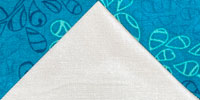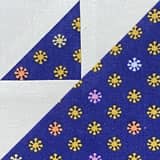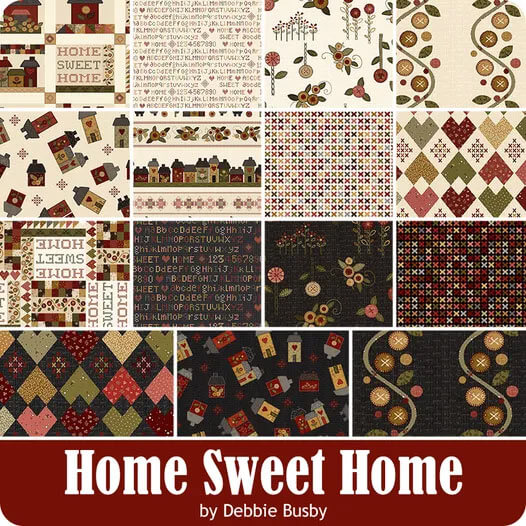- Home
- Beginner Quilt Blocks
Master These 13 Basic, Beginner Quilt Block Patterns and Units
...and you CAN confidently piece anything!
This post contains affiliate links, for which I receive compensation.
This handful of quilt block patterns forms the basis for probably 95% of all the pieced quilt blocks you'll ever make.
When you can piece them accurately, your finished quilt blocks are going to be a dream to work with.
No more tweaking 'cause it's off just a wee bit.

Most can be rotary cut and traditionally pieced. Some have quick piecing techniques. Still others are easily paper pieced. Even a few use specialty rulers for all you gadget-gals!
Each technique includes a list of pros and cons to help you choose the best one for your next quilting project.
Choose the quilt block patterns from the list:
- Flying Geese - singles, pairs, and triplets
Each quilt block patterns page has cutting charts for several sizes, free, downloadable paper piecing patterns and/or templates—if applicable—tips for easier piecing and instructions for cutting with directional fabrics.
Keep them close to you in your sewing room. Click here for help or troubleshooting when downloading.
The information is provided for your own personal use
Can you share it with friends?
I'd prefer you send them back
to this website for them to print their own copy.
Providing this free information is my way of thanking you for visiting—hopefully visiting often to see all the new things that are added.
Wouldn't it be
wonderful if your friends knew where to find it, too?
If you are a guild member and would like to include some of the downloads in your newsletter, please click here to contact me directly.
Top Tips for Perfect Patchwork
As you begin these simple quilt block patterns, here are my top tips for better pieced results.
- Slow down. Resist the temptation to stitch as fast as you can. You have more control at slower speeds. More control means less ripping.
- The perfect technique for a basic quilt block can vary from quilt to quilt. For instance, if I'm making Flying Geese for a Sawtooth star, 4-at-a-time—with over-sized patches—is my go-to method. However, if the block required pairs of FG stitched together, it's paper pieced units every time, to save time and increase accuracy.
- Stitch an good 1/4" seam. Take the time to do a sewing test to check that your settings yield spot-on results. Click here to learn how to check your seam allowances with a quick sewing test.
- Cut accurately. Make sure to cut exactly next to the ruler for accurately sized patches.
- Starch your fabric. Yes, I know it's an extra step. But you cut, stitch and press all more accurately with starched fabrics. (Just remember to wash the starch out at the end of your project.) You can learn more about starching here.
- Press as you go. Click here to learn this super simple pressing secret for flatter blocks than you ever dreamed possible. It works for paper piecing, too!
- Practice. There is nothing like practice to build confidence. Once you've built your confidence, you can do ANYTHING.
Let's get started!
The Building Blocks

If a particular technique isn't underlined (indicating an active link to that page) rest assured it's on the list to be written and photographed.
Please bookmark this page and to make it easy to return and find these tutorials as they are completed.
As the individual techniques are uploaded that information is published on the Generations Quilt Patterns Facebook page.
Rail Fence Quilt Block

This easy quilt block pattern is simply strips of fabric sewn together into strip sets. These strip sets are, in turn, sub-cut into blocks.
The technique for this block is frequently used in the construction of both four- and nine-patch quilt blocks.
Once you've mastered the sewing test for your seam allowance setting, you're ready for the Rail Fence!
The Techniques
#1: Strip Piecing
#2: Traditional Piecing
Half Square Triangles (HST)

Made from right angle or 90° triangles; the bias edge is the long one opposite the 90° angle. The two short edges are on the straight of grain.
These units can be pieced in a multitude of ways.
It also makes a good alternate block to reduce the total amount of piecing in your quilt designs.
The Techniques
Quarter Square Triangles (QST)

Another 90° right triangle.
This time the outside long edge opposite the right or 90° angle in the center is on the straight of grain. The short edges are on the bias.
This block can be pieced with two, three or four fabrics for lots of versatility.
The Techniques
#2: Sandwich or Quick Piecing Method
#3: Quarter Square Triangle Ruler
Half Rectangle Triangles

A kissin' cousin of the HST, the half rectangle is a unit twice as tall as it is wide.
It gets tricky to make because if you think the seam line goes through the opposite diagonal corners' edges, you'd be wrong.
Starching the fabric before cutting is essential (in my humble opinion) for accurate patches that are easy to piece into your quilt patterns.
The Technique
Four Patches

A common unit within blocks or a block in its own right, the Four Patch adds directional movement to your quilt design.
A perfect block for beginners to hone their seam allowance accuracy.
The Techniques
#1: Rotary cut patches
#2: Strip piecing
Nine Patches

Versatile for both scrappy and planned color placement, this block can be used on its own or alternated with others to form interesting chains through your quilt pattern.
The Birthday Quilt is one of my most favorite Nine Patch quilt patterns.
The Techniques
#1: Strip Piecing & Rotary Cut Patches
#2: Two from 2 Squares: A Positive/A Negative
#3: Strip Piece a Single Nine Patch
9-patch quilt blocks are some of the easiest to make, but a simple swap of units reveals an avalanche of design potential.
Check out our Even 9-Patch Block Library.
Find the inspiration for your next quilt project!
Flying Geese

Used most often as units within a block or for sashing and borders, Flying Geese add movement to a patchwork design.
The Techniques
|
#1: Rotary-cut patches #4: 3D or One Seam |
#5: Paper Piecing
|
Square in a Square

Whether it's set edge to edge in a simple design layout or part of another design, the Square in a Square is a fabulous place to show off a focus fabric or machine embroidery.
AKA: Diamond in a Square or Square in Square
The Techniques
#1: Folded Corners (AKA Stitch and Flip or Connector Corners)
#2: Paper Piecing - Free downloads of the patterns in 7 sizes
- Templates - 5 sizes to download
Economy quilt block

The Economy quilt block is the kissin' cousin of our Square in a Square—it has one additional 'round' of triangles.
Why does it merit a position on this basic quilt block patterns page?
Simply because it's used in the center of so many blocks.
Techniques
#1: Paper pieced units in 10 different sizes with free patterns to download and print
Triangle in a Square (TiaS)

A triangle in a square unit in quilting is a classic block made up of three elongated triangles with sharp angles. It has a reputation for being hard to piece.
But with a little practice and a technique you feel confident in, you'll be making these lovelies like nobody's business in no time at all.
While not as common as the other units, this one shows up time and again within blocks.
Used alternately with block with HSTs on their outside edge, it forms the optical illusion of curves.
The Techniques
#1: Paper Piecing
#2: TriRecs Rulers
#3: V Ruler by Studio 180 Designs
Birds in the Air

While not as popular as a HST or QST, this Birds in the Air block pops up in so many quilt blocks.
We also have instructions for variation of this block with a HST on the outside of the largest triangle...both paper and traditional piecing techniques include.
Techniques
1. Paper pieced - 7 sizes
2. Traditionally pieced - 7 sizes
Corner Beam

Another not-quite-so-common block. The design is formed by a square patch divided into three triangles by a 22° angle starting from a single corner point. Both sides of the two internal seams are bias edges.
Starching your fabric is a must in my opinion, regardless of the technique you choose to make this block. It adds needed stability to the fabric as you stitch the narrow point of fabric.
The Technique
Diamond Rectangle

The Diamond Rectangle is a classic quilt block pattern featuring an elongated diamond shape bordered by contrasting triangles. It is designed using a ratio of 1:2, width to height.
It is used in only a handful of blocks, most notably the Storm in a Sea.
As always, any block or unit with these acute angles and sharp points benefits from starching your quilt fabric before cutting.
Paper Piecing Technique - includes downloads of patterns in 5 sizes
After you've mastered these simple quilt blocks
Then you're ready for bigger challenges.
Visit our Free Quilt Block Patterns Library to see our ever-growing selection of patterns for your personal use.
If you're in need of inspiration, visit our Quilt Design Library which shows a variety of block patterns and layouts to help spark your own creativity!
For even more blocks to make...
For you, are quilt block patterns like potato chips...
...you can't have just one?!!
Check the amazing resources I rely on for the majority of the quilt block designs you see on this website.
To see if they're worthy of spot in YOUR quilting library, read about them HERE.
NOTE: All the attribution and alternate names shared in the Free Quilt Block Patterns Library came from these four resources.
- Home
- Beginner Quilt Blocks
















